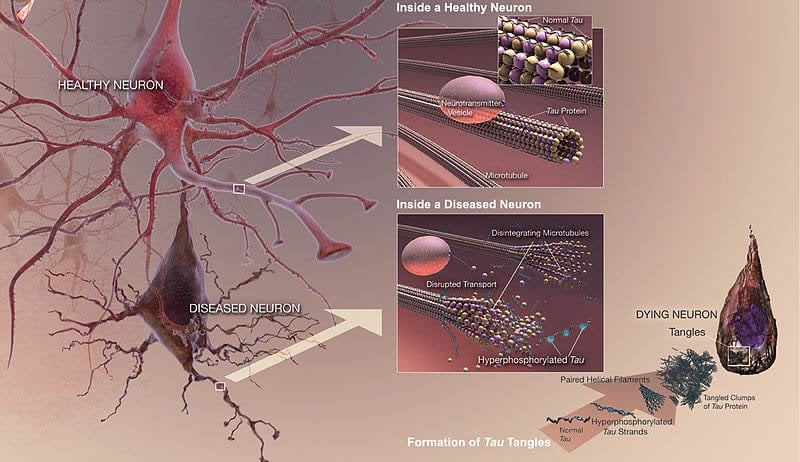Diabetes may be linked to the buildup of tangles or tau in the brain, separate from Alzheimer’s disease, according to a new study published in the September 2, 2015, online version of Neurology.
“Evidence shows that people with type 2 diabetes have double the risk of developing dementia,” said study author Velandai Srikanth, MD, PhD, from Monash University in Melbourne, Australia. “This interesting development further defines how the diseases may be connected.”
The study involved 816 people with an average age of about 74. Of those, 397 had mild cognitive impairment, which can be a precursor to dementia, 191 had Alzheimer’s disease dementia and 228 people had no memory and thinking problems. A total of 124 of the participants had diabetes.
The study looked at the relationship between type 2 diabetes, the loss of brain cells and their connections, the levels of beta amyloid (a sticky buildup of plaques) and tau or tangles of protein in the spinal fluid of the participants.
The study found that those with diabetes had on average 16 picograms per milliliter greater levels of the tau protein in the spinal and brain fluid irrespective of the diagnosis of dementia. Greater levels of tau in spinal fluid may reflect a greater build-up of tangles in the brain. These tangles may eventually contribute to the development of dementia.
It also found that diabetes was associated with a reduced thickness of the cortex, the layer of the brain with most nerve cells. People with diabetes had cortical tissue that was an average of 0.03 millimeter less than those who did not have diabetes, whether they had no thinking and memory problems, mild cognitive impairment or dementia due to Alzheimer’s disease. The buildup of tangles may contribute to this loss of brain tissue.

“Due to the fact that nerve cells in the brain do not replace themselves, it is extremely important to find ways to reduce the death of current brain cells. Studies such as ours seek to understand how diseases like diabetes may directly or indirectly affect brain cell death,” said Srikanth.
He noted that because the study looked at participants’ data at one point in time, it does not determine whether there is a cause-and-effect relationship between diabetes and the brain tangles.
Funding: The study was based on data from the US Alzheimer’s Disease Neuroimaging Initiative and was supported by the National Institutes of Health.
Source: Rachel Seroka – American Academy of Neurology
Image Source: The image is credited to NIH and is in the public domain
Original Research: Abstract for “Type 2 diabetes mellitus and biomarkers of neurodegeneration” by Chris Moran, Richard Beare, Thanh G. Phan, David G. Bruce, Michele L. Callisaya, and Velandai Srikanth, On behalf of the Alzheimer’s Disease Neuroimaging Initiative (ADNI) in Neuron. Published online September 2 2015 doi:10.1212/WNL.0000000000001982
Abstract
Type 2 diabetes mellitus and biomarkers of neurodegeneration
Objective: Our objective was to investigate whether type 2 diabetes mellitus (T2DM) influences neurodegeneration in a manner similar to Alzheimer disease (AD), by promoting brain β-amyloid (Aβ) or tau.
Methods: We studied the cross-sectional associations of T2DM with cortical thickness, brain Aβ load, and CSF levels of Aβ and tau in a sample of people from the Alzheimer’s Disease Neuroimaging Initiative with diagnoses of AD dementia, mild cognitive impairment, and normal cognition. All (n = 816) received MRI, and a subsample underwent brain amyloid imaging (n = 102) and CSF Aβ and tau measurements (n = 415). Analyses were performed across and within cognitive diagnostic strata.
Results: There were 124 people with T2DM (mean age 75.5 years) and 692 without T2DM (mean age 74.1 years). After adjusting for age, sex, total intracranial volume, APO ε4 status, and cognitive diagnosis, T2DM was associated with lower bilateral frontal and parietal cortical thickness (mL) (β = −0.03, p = 0.01). T2DM was not associated with 11C Pittsburgh compound B standardized uptake value ratio (AU) in any brain region or with CSF Aβ42 levels (pg/mL). T2DM was associated with greater CSF total tau (pg/mL) (β = 16.06, p = 0.04) and phosphorylated tau (β = 5.84, p = 0.02). The association between T2DM and cortical thickness was attenuated by 15% by the inclusion of phosphorylated tau.
Conclusions: T2DM may promote neurodegeneration independent of AD dementia diagnosis, and its effect may be driven by tau phosphorylation. The mechanisms through which T2DM may promote tau phosphorylation deserve further study.
“Type 2 diabetes mellitus and biomarkers of neurodegeneration” by Chris Moran, Richard Beare, Thanh G. Phan, David G. Bruce, Michele L. Callisaya, and Velandai Srikanth, On behalf of the Alzheimer’s Disease Neuroimaging Initiative (ADNI) in Neuron. Published online September 2 2015 doi:10.1212/WNL.0000000000001982






